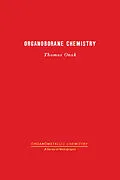Organoborane Chemistry deals with the chemistry of organoboranes, with emphasis on compounds containing a carbon-boron bond. The structure and physical properties of organoboranes are discussed, along with the reactions of three-coordinate and four-coordinate organoboranes, organodiboranes, and other organopolyboranes such as organotetraboranes and organopentaborane compounds. Comprised of seven chapters, this book begins with an overview of multistep synthetic or degradative reactions involving organoboron compounds, along with the nomenclature for such compounds. The next chapter examines the structure and physical properties of organoboranes, with emphasis on boron-carbon bond lengths, electronic transitions, and molecular orbital calculations. Subsequent chapters focus on three-coordinate and four-coordinate organoboranes, together with their synthesis, reactions, and properties; hydroboration and dehydroboration of organodiboranes; and the synthesis, reactions, and physical properties of other organopolyboranes such as organotetraboranes, organopentaborane compounds, and organodecaborane compounds. The final chapter is devoted to cyclic boron-carbon systems and the applications of organoboron compounds. This monograph should be of interest to organic chemists.
Inhalt
Preface
Chapter 1 Introduction and Nomenclature
Text
Chapter 2 Structure and Physical Properties of Organoboranes
2-1. Boron-Carbon Bond Lengths
2-2. Boron-Carbon Bonding Characteristics
2-3. Nuclear Magnetic Resonance
Boron-11
Proton
Spin Coupling
2-4. Vibrational Spectroscopy
2-5. Electronic Transitions
2-6. Mass Spectrometry
2-7. Molecular Orbital Calculations
2-8. Thermodynamic Properties
2-9. Miscellaneous Properties
Chapter 3 Three-Coordinate Organoboranes
3-1. Boron-Carbon Bond Construction
Transmetallation
Redistribution and Exchange Reactions
Hydroboration
Haloboration
Modified Friedel-Crafts Reaction
Cyclization by Loss of H2
Diboration with Diboron(4) Compounds
Formation of Boron-Carbon Bonds by the Action of Metals (or Metal Boron Compounds) on Halides
Miscellaneous Preparative Reactions
3-2. Boron-Carbon Bond Cleavage and Other Reactions
Protodeboronation and Hydrolysis of the Carbon-Boron Bond
Autoxidation
Action of Peroxides and Related Compounds
Halogens
Reactions of Organoboranes with N-Chloroamines
Other Oxidative Reactions
Radical Reactions
Transmetallation
Dehydroboration and Isomerization Reactions
Other Elimination Reactions
Reactions with Unsaturated Systems
Migration of Halogen from Carbon to Boron
Migration of Boron-Attached Organic Group to an Electropositive Center: Organoboranes as Alkylating (or Arylating) Agents
Hydrogenolysis
Reactions of Organoboranes with Alkali Metals
Miscellaneous Reactions
Chapter 4 Four-Coordinate Organoboranes
4-1. Organoborohydride Ions
Synthesis
Reactions and Properties
4-2. Organoborane-Lewis Base Adducts, RBXYD (D = Donor Group)
Synthesis and Stability
Reactions
4-3. Organoboronium Ions
4-4. Carbon Monoxide-Borane; H3BCO
Synthesis
Reactions
Physical Properties
Chapter 5 Organodiboranes
5-1. Synthesis
Exchange Reactions
Reductions with Metal Hydrides
Hydroboration
Reduction of Organoboron Esters and Halides with Diborane
Dehydroboration
Insertion
Miscellaneous Preparative Reactions
5-2. Reactions
Hydrolysis, Alcoholysis, and Related Reactions
Oxidation and Oxidative Hydrolysis
Disproportionation and Exchange Reactions
Hydroboration
Coordination Compounds with Lewis Bases
Diborane-Borane Equilibrium
Miscellaneous Reactions
5-3. Physical Properties
Structure
Nuclear Magnetic Resonance
Vibrational Spectroscopy
Mass Spectrometry
Chapter 6 Other Organopolyboranes
6-1. Carbon Monoxide-Triborane
6-2. Organotetraboranes
Alkyltetraborane(10) Compounds
Tetraborane(8)carbonyl
6-3. Organopentaborane(9) Compounds
Synthesis
Reactions
Physical Properties
6-4. Organopentaborane(11) Compounds
6-5. Organohexaborane(10) Compounds
6-6. Organodecaborane(14) Compounds
Synthesis
Reactions and Properties
6-7. Organic Derivatives of Large Closed-Cage Boron Hydrides
Chapter 7 Supplementary Chemistry
7-1. Cyclic Boron-Carbon Systems
7-2. Influence of th e Organic Group on the Properties of the Attached Boron-Containing Moiety
7-3. Influence of Boron Substitution on th e Properties of the Attached Organic Group
7-4. Analysis of Organoboron Compounds
7-5. Uses and Applications of Organoboron Compounds
Supplementary Sources of Information
Bibliography
Author Index
Subject Index
